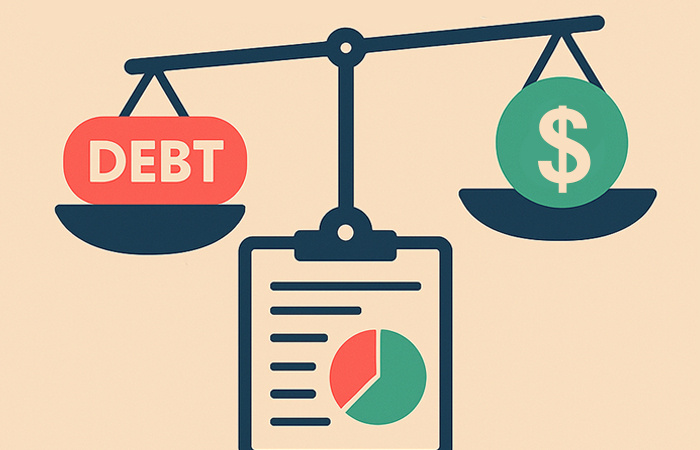One of the first steps in getting out of debt is to analyze calculate your debt-to-income ratio.
Your debt-to-income ratio (DTI) is a valuable approach for gauging your debt levels - how to get an objective point of view on "how much is too much." And in addition to your credit history and score, your DTI is one of the factors lenders evaluate when considering whether or not to loan money.
This often-overlooked metric can be the key to unlocking better loan terms, improving your financial health, and achieving your long-term financial goals. But what exactly is a DTI, and why does it matter?
What is a Debt-to-Income Ratio?
At its core, your debt-to-income ratio is a simple calculation that compares your monthly debt payments to your monthly income. It's a number that lenders use to gauge your ability to manage monthly payments and repay the money you've borrowed. But it's more than just a number for lenders - it's a powerful tool for assessing your financial health.
To calculate your DTI, you'll need to follow these steps:
- Add up all your monthly debt payments
- Calculate your gross monthly income (that's your income before taxes and other deductions)
- Divide your total monthly debt by your gross monthly income
- Multiply the result by 100 to get a percentage
For example, if your monthly debt payments total $2,000 and your gross monthly income is $6,000, your DTI would be 33.33% (2,000 ÷ 6,000 = 0.3333, then multiply by 100 to get the percentage).
As a gauge of financial health, one important debt-to-income ratio to keep in mind is 43% - the highest level most lenders consider sustainable.
Front-End vs. Back-End Ratios: A Tale of Two DTIs
When it comes to mortgages, lenders often look at two types of debt-to-income ratios: the front-end ratio and the back-end ratio. Understanding these differences can give you valuable insight into how lenders view your financial situation.
The front-end or housing ratio looks at how much of your income would go toward housing expenses. These expenses include your potential mortgage payment, property taxes, homeowners insurance, and homeowners’ association fees. Lenders typically prefer to see a front-end ratio of 28% or less.
On the other hand, the back-end ratio is what we typically think of as the standard DTI. It includes all your monthly debt obligations, including your potential mortgage payment and other debts like car loans, student loans, and credit card payments. Most lenders prefer a back-end ratio of 36% or less, although some may go as high as 43% for qualified borrowers.
Why Your DTI Matters
Your debt-to-income ratio is more than just a number - it's a snapshot of your financial health. A lower DTI indicates that you have a good balance between debt and income. In other words, you have enough income to cover your debts and living expenses. This balance can open doors to better loan terms and lower interest rates.
Conversely, a high DTI might signal that you're stretched too thin financially - potentially making it harder to save for future goals or handle unexpected expenses. It might also make lenders nervous about your ability to take on additional debt.
While a high DTI doesn't directly affect your credit score, it can have several other significant impacts:
Impact on Renting
Landlords often check credit scores and DTI ratios before leasing out their property. A high DTI might suggest to landlords that you have too much debt relative to your income, which could lead to difficulty keeping up with rent payments. As a result, you might be required to pay a higher security deposit, or in some cases, your rental application could be declined.
Insurance Rates
Insurance companies consider various factors when determining rates. While DTI is not a direct criterion, the financial habits that lead to a high DTI (like maxed-out credit cards) can negatively impact your credit score. In some states, a lower credit score can result in higher auto and homeowners’ insurance premiums.
Future Borrowing Capacity
A high DTI ratio limits your ability to take on new debt because lenders view an already high ratio as a risk factor. This situation can be particularly problematic if you face unexpected expenses or opportunities where you need to borrow funds, such as medical emergencies or business investments.
Improving Your DTI
If your debt-to-income ratio is higher than you'd like, don't despair. There are several strategies you can explore to bring it down:
- Pay down existing debts - Focus on paying off high-interest debts first to reduce your monthly obligations.
- Avoid taking on new debts - Try to put major purchases on hold until you've lowered your DTI.
- Increase your income - Look for ways to boost your earnings, whether through a raise, a side job, or passive income sources.
- Refinance or consolidate debts - This could potentially lower your monthly payments, helping you pay off debt faster.
- Create a budget - Understanding where your money goes each month can help you identify areas where you can cut back.
Remember, improving your DTI is a journey, not a destination. It's about creating sustainable financial habits that will serve you well in the long run.
The Bottom Line
Your debt-to-income ratio is a powerful indicator of your financial health. Whether you're applying for a mortgage, considering a significant purchase, or simply trying to improve your financial wellness, keeping an eye on your DTI can help guide your decisions and set you on the path to financial success.

